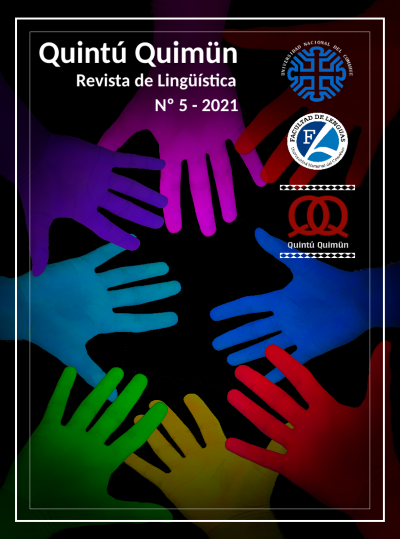Second Language Acquisition in Non-Formal Contexts in Argentina: L2 Spanish of L1 Guarani and Toba Speakers
Main Article Content
Abstract
In this paper we analyze two situations of the acquisition of Spanish as a second language (L2) in Argentina: the case of L1 Guarani and L1 Toba speakers, that shows two peculiarities in contrast with other studies of foreign language acquisition. On the one hand, L2 Spanish acquisition in these situations occurs in a non-formal context, and, on the other hand, the L1 of these speakers is, typologically speaking, distant from Spanish. This entails a radical interaction between properties of languages far away from each other and shows, in an original way, what happens with less-studied languages at the present. Based on our own data, we describe and analyze some properties of the interlanguage of these speakers. Furthermore, from the point of view of Generative Grammar (Chomsky 1981, 1986), we evaluate the impact that these properties have on the fields of language acquisition, language contact and foreign language teaching. Additionally, we argue how this type of study contributes to the reflections on sociolinguistic representations of non-dominant languages and their study in the domains of political linguistics and education.
Downloads
Article Details
Los autores de los artículos publicados conservan los derechos de copyright.
Licencia de uso:

Creative Commons Atribución-NoComercial-CompartirIgual 4.0 Internacional.
References
Adjémian, Christina (1992[1982]). La especificidad de la interlengua y la idealización en el análisis de segundas lenguas. En Juana Muñoz Liceras (comp.) La adquisición de las lenguas extranjeras. Hacia un modelo de análisis de la interlengua. Madrid: Visor, 241-262.
Aguirre, Carmen, Féliz Villalba & Myriam Najt (1996). Estudio comparativo entre la adquisición del español como primera lengua y la adquisición del español como segunda lengua para su aplicación metodológica en la enseñanza del español a inmigrantes. Madrid, Centro de Investigación y Documentación Educativa (CIDE). Disponible en: http://www.doredin.mec.es/documentos/008199900006.pdf
Avellana, Alicia (2013). Fenómenos de transferencia entre lenguas: evidencialidad en el español en contacto con el guaraní y el quechua. Estudios de Lingüística de la Universidad de Alicante 27: 31-60.
Avellana, Alicia (2014). El español en contacto con el guaraní: valores aspectuales en el dominio nominal y clausal. Revista Española de Lingüística 43 (2): 5-36.
Bruhn de Garavito, John & Lydia White (2002). The L2 acquisition of Spanish DPs. The Status of grammatical features”. En Ana T. Pérez-Leroux & Juana Liceras (eds.) The Acquisition of Spanish Morphosyntax: The L1/L2 Connection. Dordrecht: Kluwer, 151-176.
Bruno, Sebastián (2013). El proceso migratorio paraguayo hacia Argentina: evolución histórica, dinámica asociativa y caracterización sociodemográfica y laboral. En Cuadernos Migratorios Nº 4. Migrantes paraguayos en argentina: Población, instituciones y discursos. Buenos Aires: Organización Internacional para las Migraciones.
Cain, Jacquelin, Marcia Weber-Olsen & Rosslyn Smith (1987). Acquisition strategies in a first and second language: are they the same? Journal of Child Language 14 (2): 333-352.
Censabella, Marisa (2007). Criterios de asignación de género gramatical en toba. Liames 7: 41-60.
Chomsky, Noam (1981). Lectures on Government and Binding. Dordrecht: Foris.
Chomsky, Noam (1986). Knowledge of Language, its Nature, Origin and Use. New York: Praeger.
Corder, Stephen Pit (1992[1971]). Dialectos idiosincrásicos y análisis de errores. En J. Muñoz Liceras (comp.) La adquisición de las lenguas extranjeras. Hacia un modelo de análisis de la interlengua. Madrid: Visor, 63-77.
Ellis, Rod (1985). Understanding second language acquisition. Oxford: Oxford University Press.
Gómez Rendón, Jorge (2008). Typological and social constraints on language contact. Utrecht: LOT.
Halle, Morris & Alex Marantz (1993) Distributed Morphology and the pieces of inflection. En: K. Hale y S. Keyser (eds.) The View from Building 20. Cambridge: MIT Press, 111-176.
Hecht, Ana Carolina (2015). Hablar de hacerse grande, hacerse grande al hablar. Ciclo vital y lenguaje en un contexto de cambio lingüístico. En C. Messineo y A. C. Hecht (eds.) Lenguas indígenas y lenguas minorizadas. Estudios sobre la diversidad (socio)lingüística de la Argentina y países limítrofes. Buenos Aires, Argentina: Editorial Universitaria de Buenos Aires, 315-334.
INDEC. (2004-5). Encuesta Complementaria de Pueblos Indígenas (ECPI). Buenos Aires: Instituto Nacional de Estadísticas y Censos. Disponible en: https://www.indec.gob.ar
INDEC. (2010). Censo Nacional de Población, Hogares y Viviendas. Buenos Aires: Instituto Nacional de Estadísticas y Censos. Disponible en: https://www.indec.gob.ar
Krivoshein, Natalia & Graziella Corvalán (1987). El español del Paraguay en contacto con el guaraní. Asunción: Centro Paraguayo de Estudios Sociológicos.
Larsen-Freeman, Diane & Michael Long (1994). Introducción al estudio de la adquisición de segundas lenguas. Madrid: Gredos.
McCarthy, Corrine (2005). Underspecification and default morphology in second language Spanish. Boston University Conference on Language Development (BUCLD 29) Online Proceedings Supplement.
Messineo, Cristina (2003). Lengua toba (guaycurú). Aspectos gramaticales y discursivos. Lincom Studies in Native American Linguistics 48. Munich: Lincom Europa Academic Publisher.
Nemser, William (1992[1971]). Los sistemas aproximados de los que aprenden lenguas segundas.En Juana Muñoz Liceras (comp.) La adquisición de las lenguas extranjeras. Hacia un modelo de análisis de la interlengua. Madrid: Visor, 51-61.
Pérez-Pereira, Miguel (1991). The acquisition of gender: What Spanish children tell us.Journal of Child Language 18: 571-590.
Selinker, Larry (1992[1972]). La interlengua. En Juana Muñoz Liceras (comp.) La adquisición de las lenguas extranjeras. Hacia un modelo de análisis de la interlengua. Madrid: Visor, 79-101.
Schmitt, Cristina, Alicia Avellana & Lucía Brandani (En elaboración). Corpus ARPAR contact. Corpus en desarrollo en el marco del proyecto BCS-1656133 (2017-2019) Variation and variability in the acquisition of Paraguayan Spanish spoken in Buenos Aires, financiado por NSF (National Science Foundation, EE.UU).
Tarone, Elaine (1992[1983]). La variabilidad de la interlengua. En Juana Muñoz Liceras (comp.) La adquisición de las lenguas extranjeras. Hacia un modelo de análisis de la interlengua. Madrid: Visor, 263-307.
Thomason, Sarah & Terrence Kaufman (1988). Language Contact, Creolization, and Genetic Linguistics. Berkeley: University of California Press.
Tsao, Feng-Fu (1977). A Functional Study of Topic in Chinese: A First Step Toward Discourse Analysis. Tesis Doctoral, Universidad de California del Sur.
Usher de Herreros, Beatriz (1976). Castellano paraguayo: notas para una gramática contrastiva castellano-guaraní. Suplemento Antropológico (Asunción, Universidad Católica)11 (1-2): 29-123.
Velázquez Castillo, Maura. & Mary Hudgens (2013). Quiero para mi novio. Aspectual uses of para in Paraguayan Spanish. Journal of Pidgin and Creole Languages28(1): 65-102.
